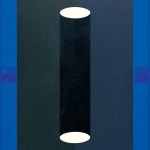Imran Mir
Untitled (Ninth Paper on Modern Art), 1997
Acrylic on canvas
180 x 152 cm
70 7/8 x 59 7/8 in
70 7/8 x 59 7/8 in
Signed and dated 'IMRAN MIR/ KARACHI 97' on the reverse
Further images
The paintings of Imran Mir bore no overt signs of his restless, edgy personality. And that was measured and considered. It was the facture of the line, the plane and...
The paintings of Imran Mir bore no overt signs of his restless, edgy personality. And that was measured and considered. It was the facture of the line, the plane and the point at which they met in space that created the drama and tension within the painting to build the narrative. Once Mir had secured the mathematical arrangement of his theoretical representation, he could engage with the formula as he wished. He could revise it, create trompe l’oeil, box it up, erect it and take it apart. It was his to play. The optical illusions he created in his 'Ninth Paper on Modern Art' encapsulate a prolific period of painting.
There was reasoning for it all: the color fields; the objects; the cylinders, tubes, cuboids, tetrahedrons, arcs, dots—all existing through a thought logic that played their part in bringing balance and equilibrium to the spatial dimension.
The sets of colours complemented or contrasted each other, creating a visceral perceptual effect. In most of his paintings, the objects lie at the centre, pulling the viewer’s attention towards it and then outwards to the smaller semiotics that sit on the outlying peripheries. In the paintings, there are sure to be spaces where the eyes can rest so that the viewer is offered space and time to linger on each element of the painting. The arrangement is, therefore, always thoughtful.
Persuasions in Liminal Spaces, Nafisa Rizvi, 2022
There was reasoning for it all: the color fields; the objects; the cylinders, tubes, cuboids, tetrahedrons, arcs, dots—all existing through a thought logic that played their part in bringing balance and equilibrium to the spatial dimension.
The sets of colours complemented or contrasted each other, creating a visceral perceptual effect. In most of his paintings, the objects lie at the centre, pulling the viewer’s attention towards it and then outwards to the smaller semiotics that sit on the outlying peripheries. In the paintings, there are sure to be spaces where the eyes can rest so that the viewer is offered space and time to linger on each element of the painting. The arrangement is, therefore, always thoughtful.
Persuasions in Liminal Spaces, Nafisa Rizvi, 2022
Provenance
The Estate of the ArtistExhibitions
Stedelijk Museum, Amsterdam, Abstracting Parables, 1 July - 16 October, 2022Publications
Imran Mir, what you see is what you see, Karachi, Pakistan, 2014, p. 126Imran Mir, A world that is not entirely reflective but contemplative, Archive Books, Berlin, 2022, p. 58





